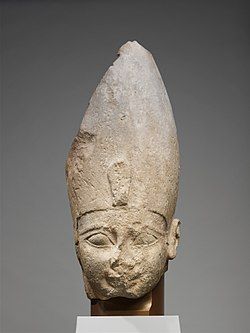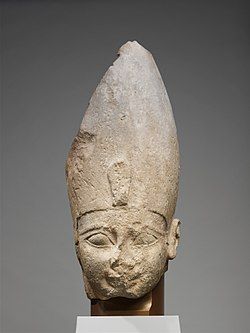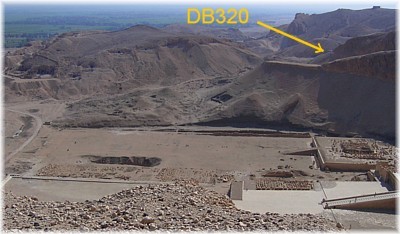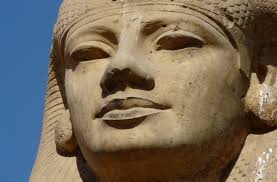Ahmose I (Egyptian: Jˁḥ ms(j.w), sometimes written Amosis I, "Amenes" and "Aahmes" and meaning Born of Iah was a pharaoh of ancient Egypt and the founder of the Eighteenth dynasty. He was a member of the Theban royal house, the son of pharaoh Seqenenre Tao and brother of the last pharaoh of the Seventeenth dynasty, King Kamose. During the reign of his father or grandfather, Thebes rebelled against the Hyksos. When he was seven years old his father was killed, and he was about ten when his brother died of unknown causes, after reigning only three years. Ahmose I assumed the throne after the death of his brother, and upon coronation became known as Neb-Pehty-Re (The Lord of Strength is Re). The name Ahmose is a combination of the divine name 'Ah' (see Iah) and the combining form '-mose'.
During his reign, he completed the conquest and expulsion of the Hyksos from the delta region, restored Theban rule over the whole of Egypt and successfully reasserted Egyptian power in its formerly subject territories of Nubia and Canaan. He then reorganized the administration of the country, reopened quarries, mines and trade routes and began massive construction projects of a type that had not been undertaken since the time of the Middle Kingdom. This building program culminated in the construction of the last pyramid built by native Egyptian rulers. Ahmose's reign laid the foundations for the New Kingdom, under which Egyptian power reached its peak. His reign is usually dated to the mid-16th century BC.
When Ahmose gained power, upper and lower Egypt were held by enemies. He began the conquest of upper Egypt held by the Hyksos and was able to win back lost land there after a 3 year war. A military campaign went perhaps as far as the Euphrates River. Then he won back lower Egypt with his armies.
It was possible that Ahmose I may have originally been buried in the southern part of Dra' Abu el-Naga' with the rest of the late 17th and early 18th Dynasties. But proof is difficult to find. His mummy was discovered
in 1881 within the Deir el-Bahri Cache, located in the hills directly above the Mortuary Temple of Hatshepsut. He was interred along with the mummies of other 18th and 19th dynasty leaders Amenhotep I, Thutmose I, Thutmose II, Thutmose III, Ramesses I, Seti I, Ramesses II and Ramesses IX, as well as the 21st dynasty pharaohs Pinedjem I, Pinedjem II and Siamun.
Ahmose I's mummy was unwrapped by Gaston Maspero on June 9, 1886. It was found within a coffin that bore his name in hieroglyphs, and on his bandages his name was again written in hieratic script. While the cedarwood coffin's style dates it squarely to the time of the 18th dynasty, it was neither of royal style nor craftsmanship, and any gilding or inlays may have been stripped in antiquity. He had evidently been moved from his original burial place, re-wrapped and placed within the cache at Deir el-Bahri during the reign of the 21st dynasty priest-king Pinedjem II, whose name also appeared on the mummy's wrappings. Around his neck a garland of Delphinium flowers had been placed. The body bore signs of having been plundered by ancient grave-robbers, his head having been broken off from his body and his nose smashed. (Bio courtsey of Wixipedia).
Ahmose I (Egyptian: Jˁḥ ms(j.w), sometimes written Amosis I, "Amenes" and "Aahmes" and meaning Born of Iah was a pharaoh of ancient Egypt and the founder of the Eighteenth dynasty. He was a member of the Theban royal house, the son of pharaoh Seqenenre Tao and brother of the last pharaoh of the Seventeenth dynasty, King Kamose. During the reign of his father or grandfather, Thebes rebelled against the Hyksos. When he was seven years old his father was killed, and he was about ten when his brother died of unknown causes, after reigning only three years. Ahmose I assumed the throne after the death of his brother, and upon coronation became known as Neb-Pehty-Re (The Lord of Strength is Re). The name Ahmose is a combination of the divine name 'Ah' (see Iah) and the combining form '-mose'.
During his reign, he completed the conquest and expulsion of the Hyksos from the delta region, restored Theban rule over the whole of Egypt and successfully reasserted Egyptian power in its formerly subject territories of Nubia and Canaan. He then reorganized the administration of the country, reopened quarries, mines and trade routes and began massive construction projects of a type that had not been undertaken since the time of the Middle Kingdom. This building program culminated in the construction of the last pyramid built by native Egyptian rulers. Ahmose's reign laid the foundations for the New Kingdom, under which Egyptian power reached its peak. His reign is usually dated to the mid-16th century BC.
When Ahmose gained power, upper and lower Egypt were held by enemies. He began the conquest of upper Egypt held by the Hyksos and was able to win back lost land there after a 3 year war. A military campaign went perhaps as far as the Euphrates River. Then he won back lower Egypt with his armies.
It was possible that Ahmose I may have originally been buried in the southern part of Dra' Abu el-Naga' with the rest of the late 17th and early 18th Dynasties. But proof is difficult to find. His mummy was discovered
in 1881 within the Deir el-Bahri Cache, located in the hills directly above the Mortuary Temple of Hatshepsut. He was interred along with the mummies of other 18th and 19th dynasty leaders Amenhotep I, Thutmose I, Thutmose II, Thutmose III, Ramesses I, Seti I, Ramesses II and Ramesses IX, as well as the 21st dynasty pharaohs Pinedjem I, Pinedjem II and Siamun.
Ahmose I's mummy was unwrapped by Gaston Maspero on June 9, 1886. It was found within a coffin that bore his name in hieroglyphs, and on his bandages his name was again written in hieratic script. While the cedarwood coffin's style dates it squarely to the time of the 18th dynasty, it was neither of royal style nor craftsmanship, and any gilding or inlays may have been stripped in antiquity. He had evidently been moved from his original burial place, re-wrapped and placed within the cache at Deir el-Bahri during the reign of the 21st dynasty priest-king Pinedjem II, whose name also appeared on the mummy's wrappings. Around his neck a garland of Delphinium flowers had been placed. The body bore signs of having been plundered by ancient grave-robbers, his head having been broken off from his body and his nose smashed. (Bio courtsey of Wixipedia).
Gravesite Details
Алеся (50942221) provided the father link.
Family Members
Advertisement
Explore more
Sponsored by Ancestry
Advertisement
















